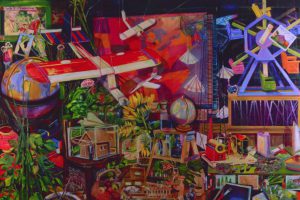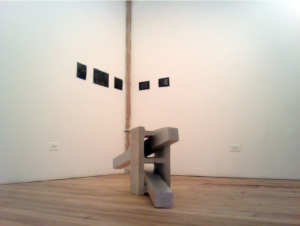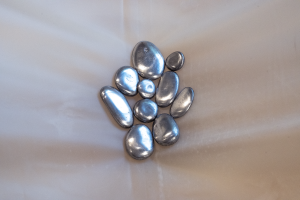In the wake of her 30th birthday, I joined Andrea Sparr-Jaswa in her beautifully decorated Logan Square apartment. Andrea is a long time resident of the neighborhood and a contributing writer to the Chicago Arts Archive. Amidst bites of fudge cake, we chatted about Andrea’s academic background, and her opinions on art, Chicago, and orbital sanders. Sixty on Sixty is a new series in which SIFCers interview one another, allowing readers to get to know the fine folks who bring you the latest from Chicago’s art scene.
Tell me a bit about your educational background. How did you get involved with art history and writing for the arts?
I went to college for a while, changing my majors and trying to figure out what I wanted to do. Art history was always the class that I wouldn’t miss, even if it was at 8 AM. I always liked writing the papers, and I always enjoyed doing the work. It always seemed so fascinating to me. For a while I pushed against it, because I figured I wasn’t going to be able to make any money doing it. I tried my hand at some other things and figured out I didn’t love them as much.
I ended up moving to Chicago and finishing my degree at Columbia, and I’m really glad I made that decision. I started out at Ohio State in Columbus. It was a good school and I had some amazing teachers. Some of the teachers were part of the reason why I continued pursuing art history in the end, but I’m happy with having gone to Columbia just because of the size of the program, the one-on-one interaction, and the stories that I was able to get from my professors. It’s really hard to find teachers who not only work in the field and have a lot of connections and amazing stories to tell, but also want to teach and give their experience to you. I found that at Columbia.
As far as writing for the arts I didn’t do much until Nikki and Tempestt came up with this project. It was with the start of SIFC that I started doing contributions for the Internet.

What kind of art do you like?
One of the nice things about having studied art history is that despite any sort of predilections I had to particular aesthetic movements, I learned to appreciate everything. One of my favorite parts of art is discovering something new. I’m into everything from Byzantine to [Pieter] Bruegel, from French Realism to [Gerhard] Richter, from Northern song scrolls to Subodh Gupta. It’s all over the place. As far as a favorite I can’t say that I have one, although I do foresee myself eventually leaning towards architectural preservation as far as a career. I like the tangible built environment, and the way we can interact with space. I see myself doing that as a career, while maintaining my connections to the world of visual arts.
What kind of art don’t you like?
That’s a tough question really. Maybe it’s a little controversial, but I can’t say that I’m really into Outsider art. Maybe that’s because I haven’t allowed myself to be exposed to it or really understand it. Perhaps it’s because of my art history background, but I appreciate a certain skill set that can be built upon. That knowledge of where you’re coming from is going to allow you to make a jumping off point, even if you end up drawing like a 5-year-old. You’ve got to know where you’re coming from, and why you are doing that. So, Outsider art is probably one of the few things that I least understand. I don’t know if I don’t like it, but it’s certainly the [type of art] that I least understand.
You’re planning on taking a road trip to Quebec. How is your French?
I can get by. It’s the one language I know the best. I’ve always been interested in language. I lived in France for 2.5 months when I was 12, [as part of] a Back-to-Back program. I’ve been hooked since then as far as travel and language is concerned. I pursued French and I’ve been back [to France] several times. I toured Europe with a national band and choir when I was seventeen, so I’ve done a lot of travel. It is really a very addicting and expensive habit.
Could you tell me about the show that you are curating?
This [project] is for the Milwaukee Avenue Arts Festival, which is July 29 to 31st. I went to the community meeting where I was introduced to a woman named Lucy Mueller. She is a local photographer who had exhibited [at the Milwaukee Avenue Arts Festival] the last couple of years. There was some interest sparked at the community meeting about doing a historical exhibition, and that’s definitely something I’m passionate about. I’m passionate about Logan Square and all that continues to grow within it. Having the chance to be able to focus on architecture and history for this exhibition is key for me. I never fancied myself a curator, but being able to do it from this perspective is ideal for me.
When the suggestion was made to use the Logan Theatre for a gallery space (as they are about to undertake some major renovations, and become a gallery space of their own) we took the opportunity to narrow our focus from a history of Logan Square to a history of the silent screen. We are going to be focusing on local northwest side Chicago movie palaces of the past and present. This will include [the] Logan Square [Theater], which was built in 1915, the Congress, the Portage up at six corners, and the Patio which is just about to be reopened and has been totally renovated. Then [we will cover] some of the places that are ghosts like the Harding, which was on Milwaukee right near the Logan [Theater] but has been torn down. [We will be] using photographs and memorabilia and artifacts and documents, some of which we are getting from the Logan Theater. We have full access to their storeroom which is exciting, including an old ticket machine which was used for that Johnny Depp movie about John Dillinger (“Public Enemies”). We have full access to the lobby and we get to use whatever space we want.
Not only is it the perfect space to present our exhibition, but it’s also bringing attention to the fact that they [the Logan Theater] are trying to reinvent themselves and become more of an art house. They’re putting in digital projectors as opposed to 35mm projectors, which will allow students and local film makers to exhibit their works. They’re going to be using part of the space that I am Logan Square is in right now as a gallery, so it’s going to be an integral part of the community hopefully by the end of this year.
How are you and Lucy Mueller splitting the workload?
I’ve been doing a lot of the writing and presenting the material, and we are both going to be doing research. She being a photographer has a nice large scanner, [so we will] be able to use her equipment to produce the work. It’s a good inaugural curatorial debut. It’s exciting to be able to have this opportunity.

What do you find exciting about the Chicago art scene?
I’m living in it. There are a lot of amazing things going on in this city, whether they be well-established art galleries that have been showing well-established artists for years in River North, to places like Pilsen or Logan Square that have a growing number of places where artists can be seen and heard and recognized for the work that they are doing right now. Also, there a lot of smaller spaces that are on the cusp of the cusp. They are the apartment galleries that nobody knows about, that have shows wherever they can. It seems like something new is coming up every day. The Comfort Station has become a multimedia environment for not only visual artists, but also local musicians. They are going to be doing music shows on Thursdays, and they are hosting Logan Square’s international film series on Tuesdays. There are just amazing things happening with I Am Logan Square, the Elastic Arts Center, and the Milwaukee Arts Festival. I think [all of this] is going to spur on a lot of interest and bring in a lot of people that are curious about what’s going on.
Do you do any creative work outside of writing for the arts and curating?
I have some hope to work with Logan Square Preservation as far as putting together a data base for their photo collection of all the historical buildings in the neighborhood. It’s been sort of chaotic, and I haven’t pursued that as much as I should have, but it’s definitely in the back of my mind. It’s something I want to continue to try to work on as far as making sure that there is an online archival database of all of the amazing structures that are in this area. There’s a lot of history here, and people are really interested. It’s the last comfort station; it’s the emerald necklace that was never finished. There are a lot of amazing things.
My ultimate dream from years and years ago was to buy up old historical houses and refinish them, making them into what they once were or even better. I hand sanded this table. I borrowed a belt sander and an orbital sander from my friend and I ended up hand sanding this whole thing. I like the feel of doing something with my hands. I think that’s why I’ve always liked architecture. It’s being able to have that tactile experience, and being in that environment and being able to feel it, to experience it. Whether it’s being in an amazing building like the Louvre, or just being in a house on the boulevard, or reupholstering chairs; that’s what I find the most relaxing. I’ve always liked the British arts and crafts too. Maybe it all blends together somehow. Maybe that’s why I like Chicago, it’s building stuff from the ground up.





